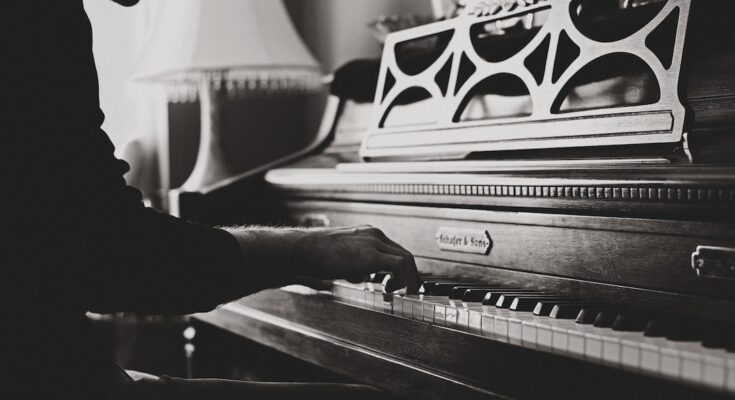R&B, short for rhythm and blues, is a genre of music that originated in African American communities in the United States in the 1940s and 50s. It is characterized by its soulful vocals, catchy melodies, and rhythmic beats. R&B has played a significant role in American music and culture, influencing various genres and artists throughout history. From its roots in jazz, blues, and gospel music to its fusion with funk, disco, and hip-hop, R&B has continuously evolved and adapted over time. In this article, we will explore the history of R&B, its impact on American culture, its influence on hip-hop, the role it plays in black culture, the contributions of female R&B artists, its future direction, its global reach, the business behind the genre’s success, and its lasting legacy.
The Roots of R&B: How the Genre Emerged in the 1940s and 50s
R&B emerged in African American communities in the United States during the 1940s and 50s. It was a fusion of various musical styles, including jazz, blues, and gospel music. The genre was born out of the need for African Americans to express their experiences and emotions through music. R&B provided a platform for artists to address social issues such as racism and inequality.
Influences from jazz can be heard in the improvisational nature of R&B music, while blues contributed to its soulful vocals and emotional lyrics. Gospel music also played a significant role in shaping R&B, with its emphasis on powerful vocals and spiritual themes. Artists like Louis Jordan, Ray Charles, and Ruth Brown were among the early pioneers of R&B and helped popularize the genre.
The Golden Age of R&B: Examining the Genre’s Peak in the 60s and 70s
The 1960s and 70s are often referred to as the golden age of R&B. During this time, Motown and Stax Records emerged as two of the most influential record labels in the genre. Motown, based in Detroit, produced hits by artists like The Supremes, Marvin Gaye, and Stevie Wonder. Stax Records, located in Memphis, was known for its roster of artists such as Otis Redding, Isaac Hayes, and Aretha Franklin.
The social and political context of the time greatly influenced R&B music. The civil rights movement and the fight for racial equality were at the forefront of American society, and R&B artists used their music to address these issues. Songs like Marvin Gaye’s “What’s Going On” and Stevie Wonder’s “Living for the City” became anthems for social change.
The Evolution of R&B: How the Genre Has Adapted and Changed Over Time
R&B has continuously evolved and adapted over time, incorporating elements from other genres such as funk, disco, and hip-hop. In the 1970s, funk music became popular, characterized by its syncopated rhythms and heavy basslines. Artists like James Brown and Parliament-Funkadelic brought a new energy to R&B with their funky grooves.
In the 1980s, disco heavily influenced R&B music with its danceable beats and catchy melodies. Artists like Michael Jackson and Prince incorporated disco elements into their R&B sound, creating a fusion that dominated the charts.
In recent years, R&B has seen the emergence of new sub-genres such as neo-soul and alternative R&B. Neo-soul combines elements of classic soul music with contemporary R&B, while alternative R&B incorporates elements from genres like electronic music and indie rock. Artists like D’Angelo, Erykah Badu, and Frank Ocean have been at the forefront of these sub-genres.
The Influence of R&B on Hip-Hop: Tracing the Genre’s Impact on Modern Rap Music
R&B has had a significant influence on hip-hop, with many rap artists sampling and borrowing from R&B songs. Sampling involves taking a portion of a pre-existing song and incorporating it into a new composition. R&B samples have been used in countless hip-hop songs, adding a melodic and soulful element to the genre.
R&B-influenced rap artists have also emerged, blurring the lines between the two genres. Artists like Drake and Frank Ocean have incorporated R&B elements into their rap music, creating a unique sound that appeals to a wide audience.
Collaborations between R&B and hip-hop artists have become increasingly common, with artists from both genres coming together to create chart-topping hits. These collaborations have helped bridge the gap between R&B and hip-hop, bringing fans of both genres together.
The Role of R&B in Black Culture: How the Genre Has Reflected and Shaped African American Experience
R&B has always been deeply rooted in African American culture, reflecting the experiences and emotions of black people in America. The genre has often addressed themes of love, heartbreak, and social justice. R&B artists have used their music as a form of resistance and empowerment, speaking out against racism and inequality.
R&B has also played a crucial role in representing black identity and culture. From the soulful vocals to the lyrical content, R&B music has provided a platform for black artists to express themselves authentically. It has served as a source of pride and inspiration for black listeners, offering a sense of belonging and cultural affirmation.
The Women of R&B: Celebrating the Genre’s Iconic Female Artists
Female artists have made significant contributions to the R&B genre throughout its history. Pioneering women like Billie Holiday and Etta James paved the way for future generations of female R&B artists. Their powerful vocals and emotional performances set the standard for the genre.
In more recent years, female R&B artists like Whitney Houston and Beyoncé have become icons in their own right. Their talent, charisma, and impact on the genre have solidified their place in music history. These women have not only achieved commercial success but have also used their platform to advocate for social change and empower other women.
Contemporary female R&B artists continue to make waves in the industry, bringing their unique styles and perspectives to the genre. Artists like Janelle Monáe, Solange, and H.E.R. are pushing boundaries and redefining what it means to be an R&B artist in the 21st century.
The Future of R&B: Predicting Where the Genre Will Go in the Coming Years
The future of R&B is bright, with new artists pushing the boundaries of the genre and incorporating elements from other genres. Contemporary R&B music has seen a resurgence in popularity, with artists like The Weeknd and SZA dominating the charts.
One trend in contemporary R&B is the fusion with electronic music, creating a sound that is both soulful and futuristic. Artists like Miguel and FKA twigs have embraced this fusion, incorporating electronic elements into their R&B sound.
Another trend is the emergence of alternative R&B artists who are experimenting with different sounds and styles. These artists are pushing the boundaries of what is considered traditional R&B, creating a more diverse and eclectic landscape for the genre.
The Global Reach of R&B: How the Genre Has Spread and Gained Fans Around the World
R&B’s influence has spread far beyond its origins in African American communities. The genre has had a significant impact on international music scenes, with artists from around the world incorporating R&B elements into their music.
In countries like Japan and South Korea, R&B has become a popular genre, with artists like Utada Hikaru and DEAN gaining a large following. R&B has also influenced artists in the UK, with acts like Amy Winehouse and Adele incorporating soulful elements into their music.
Cross-cultural collaborations in R&B music have become increasingly common, with artists from different countries coming together to create unique and innovative music. These collaborations have helped to further spread the influence of R&B and create a global community of R&B fans.
The Business of R&B: Exploring the Industry and Economics Behind the Genre’s Success
Record labels play a crucial role in the success of R&B artists. Labels like Motown and Stax Records were instrumental in shaping the genre and launching the careers of iconic artists. Today, major record labels continue to sign and promote R&B artists, providing them with the resources and support needed to succeed.
Streaming and digital sales have become increasingly important in the R&B industry. With the rise of platforms like Spotify and Apple Music, artists can reach a global audience and monetize their music more easily. However, streaming has also posed challenges for artists in terms of fair compensation and royalties.
R&B’s impact on the music industry as a whole cannot be overstated. The genre has influenced countless artists and genres, shaping the landscape of popular music. From its early days in African American communities to its global reach today, R&B continues to be a driving force in the music industry.
The Legacy of R&B: Honoring the Genre’s Contributions to American Music and Culture
R&B’s legacy is one of immense importance and influence. The genre has had a profound impact on other genres and artists throughout history. Its fusion of jazz, blues, gospel, funk, disco, and hip-hop has shaped the sound of popular music.
R&B’s impact on American culture and society cannot be overlooked. The genre has provided a platform for African Americans to express their experiences and emotions, addressing social issues and advocating for change. R&B has also played a crucial role in representing black identity and culture, providing a sense of pride and empowerment.
It is essential to preserve and celebrate the legacy of R&B. By exploring the genre’s history, appreciating its contributions, and supporting contemporary R&B artists, we can ensure that R&B continues to thrive and inspire future generations.
R&B is a genre that has had a significant impact on American music and culture. From its roots in African American communities to its global reach today, R&B has continuously evolved and adapted over time. The genre’s fusion of jazz, blues, gospel, funk, disco, and hip-hop has shaped the sound of popular music.
R&B has addressed social issues, represented black identity and culture, and provided a platform for artists to express themselves authentically. The genre’s impact on other genres and artists cannot be overstated. R&B has influenced hip-hop, inspired collaborations, and shaped the landscape of popular music.
To fully appreciate the genre’s contributions, it is important to explore its history, support contemporary R&B artists, and celebrate its legacy. By doing so, we can ensure that R&B continues to thrive and inspire future generations. So take the time to listen to some R&B music today and discover the soulful sounds that have shaped American music and culture.
R&B’s strong presence in the U.S. music scene is undeniable, but it’s always interesting to explore other genres and their impact as well. If you’re looking for something different, check out this article on the short history of reggaeton. Reggaeton has been making waves in recent years, blending elements of Latin American vibes and modern reggaeton beats. It’s a genre that has gained popularity worldwide, and this article provides a great overview of its origins and evolution. Read more here.



